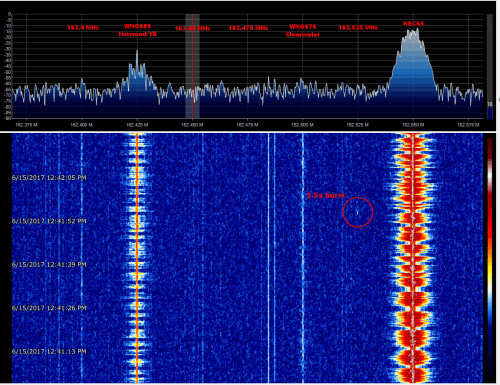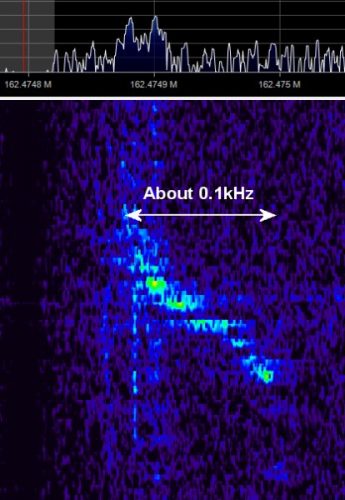Using National Weather Service Stations for Forward Scatter Meteor Detection
Over on his blog Dave Venne has been documenting his attempts at using National Weather Service (NWS) broadcasts for forward scatter meteor detection with an RTL-SDR. Forward scatter meteor detection is a passive method for detecting meteors as they enter the atmosphere. When a meteor enters the atmosphere it leaves behind a trail of highly RF reflective ionized air. This ionized air can reflect far away signals from strong transmitters directly into your receiving antenna, thus detecting a meteor.
Typically signals from analog TV and broadcast FM stations are preferred as they are near the optimal frequency for reflection of the ionized trails. However, Dave lives in an area where the broadcast FM spectrum is completely saturated with signals, leaving no empty frequencies to detect meteors. Instead Dave decided to try and use NWS signals at 160 MHz. In the USA there are seven frequencies for NWS and they are physically spaced out so that normally only one transmitter can be heard. Thus tuning to a far away station should produce nothing but static unless a meteor is reflecting its signal. Dave however does note that the 160 MHz frequency is less than optimal for detection and you can expect about 14 dB less reflected signal from meteors.
So far Dave has been able to detect several ‘blips’ with his cross-dipole antenna, RTL-SDR and SDR#. He also uses the Chronolapse freeware software to perform timelapse screenshots of the SDR# waterfall, so that the waterfall can be reviewed later. Unfortunately, most of the blips appear to have been aircraft as they seem to coincide with local air activity, and exhibit a Doppler shift characteristic that is typical of aircraft. He notes that the idea may still work for others who do not live near an airport.


We note that if you are interested in detecting aircraft via passive forward scatter and their Doppler patterns, then this previous post on just that may interest you.
This would work in a receiver with a very good front end and band pass filter but with a RTL dongle how can you be sure that they are reflected signals and not intermodulation caused from strong pagers or similar? I find plenty of these short bursts everywhere; just leave it tuned in a empty band and sooner or later some will appear.
One potential problem I see with using this approach, at least in some areas of the country (like Hawaii or the Gulf Coast) is that 162 MHz signals are very prone to tropospheric ducting.
It is not unusual here to be able to receive two or three stations reasonably well (I typically receive WXK27 Austin, Texas on 162.400 MHz very strongly, as well as WWF91 Llano on 162.425) but also often receive weaker signals from hundreds of miles away.
Just tuning around the band right now on my Yaesu FT-857 with a mag-mount 1/4 wave antenna cut for the amateur 2 meter band, I hear signals on:
* several weak stations overlapping each other, fading in and out, on 162.450; but I can make out one station ID as KWN33 in Stephenville (120 miles away from me); I also hear one station discussing the possible impacts of Tropical Storm Cindy on south-central Texas, so it might be KJY88 in Wharton (130 miles away).
* an up-and-down station on 162.500 describing the impacts of Tropical Storm Cindy on the Houston area (which I presume to be KXI55, 165 miles away, as it is the only station on that frequency in the coastal areas of the state);
* a reasonably strong signal from WNG649 in Cameron on 162.525 (56 miles away); and
* a weak signal on 162.550, WXK67 in San Antonio (about 85 miles away).
So, because of ducting, all 7 of the stations are tied up here tonight…
They might be more of a challenge to receive, but 6 meter propagation beacons might be better candidates to use for this…